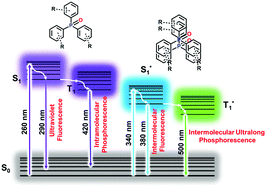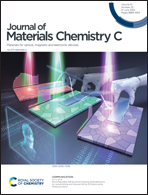Ultralong room temperature phosphorescence and ultraviolet fluorescence from simple triarylphosphine oxides†
Abstract
Achieving persistent room-temperature phosphorescence in halogen/heavy atom-free organic compounds is challenging due to the ultrafast deactivation of excited states. This study reports the ultralong room temperature phosphorescence (ULRTP) from simple triarylphosphine oxides. Although phosphine/oxides have been known for several decades and have been well exploited in catalysis, surprisingly, the ULRTP properties of these simple compounds have never been explored. The luminescence characteristics of triarylphosphines (1–4) and triarylphosphine oxides (5–8) were fine-tuned by systematically varying the steric crowding around the phosphorus center. Phosphines 1–4 show room temperature phosphorescence (RTP) with a 4.30–5.45 microsecond lifetime, while phosphine oxides 5–8 exhibit persistent RTP with millisecond lifetimes. ULRTP was observed only for the crystalline solids of 5–8 and was not observed for amorphous ground samples and thin films. Detailed steady-state, time-resolved photoluminescence (PL), crystal structure and computational studies collectively implied that the intermolecular interactions are essential for ULRTP in 5–8.

- This article is part of the themed collection: Showcasing recent research in materials chemistry from IIT Bombay, IIT Indore and IISc


 Please wait while we load your content...
Please wait while we load your content...